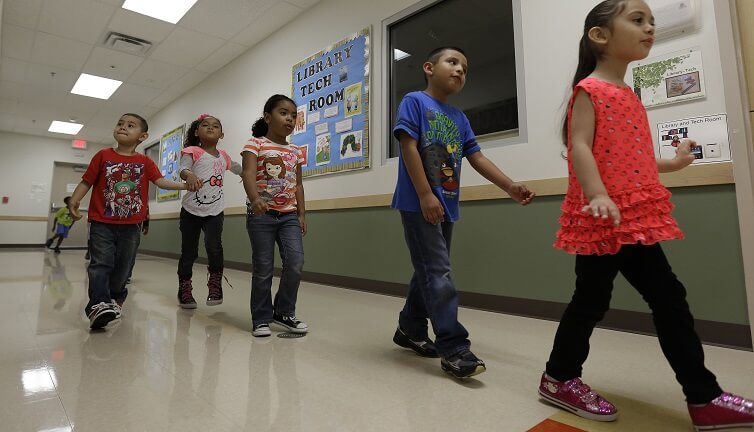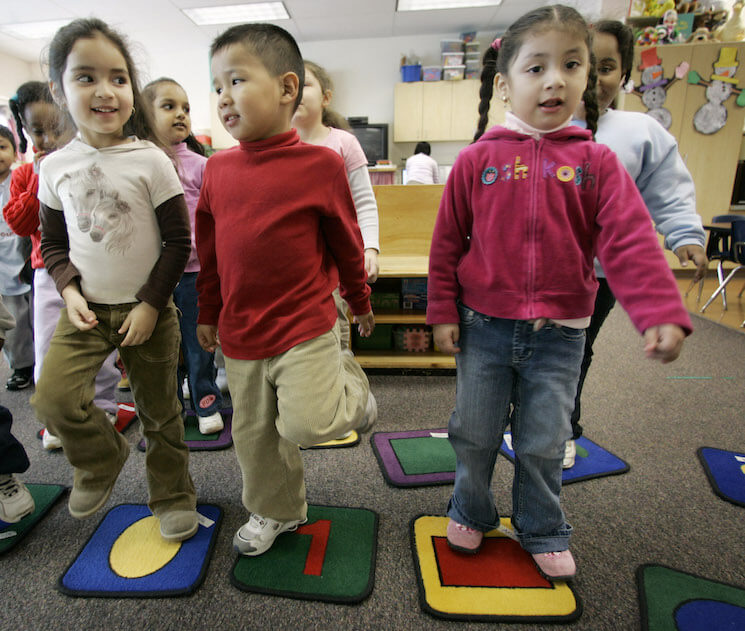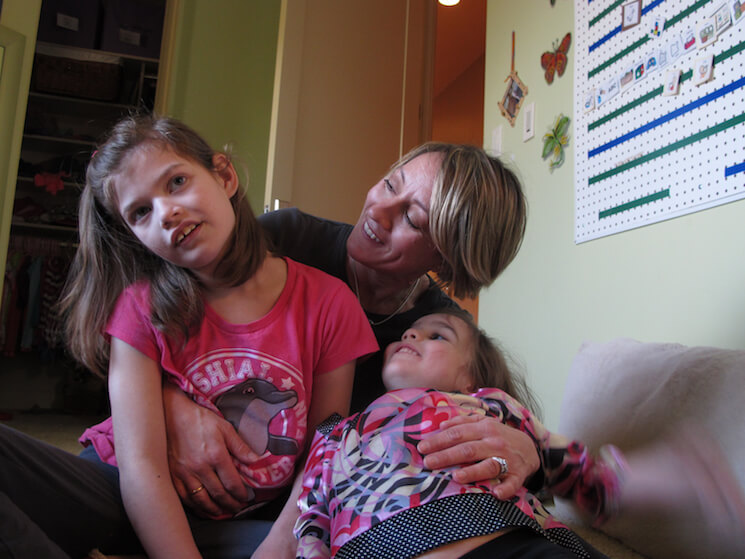How economic inequality affects children’s outcomes

About the author: Ariel Kalil is a professor of public policy at the Harris School of Public Policy Studies, University of Chicago.
What happens in the home is paramount to children’s early development. Economically disadvantaged children’s limited access to cognitively enriching home environments may help drive growing gaps in cognitive and non-cognitive skills, producing a feedback cycle that leads to low socioeconomic mobility and further grows inequality. Research increasingly suggests that policy should identify new targets for programs aimed at enhancing parent-child interactions in low-income families, such as Early Head Start and Healthy Families America. All parents want to help their children flourish, but low-income parents often lack the resources to achieve their parenting goals. Parents are children’s first teachers and, to equalize the playing field, governments need to invest in parents so that they, in turn, can better invest in their children.
![]()
Background
Economic growth for much of the 20th century supported America’s promise of offering opportunities to both parents and their children. It is well known, however, that income inequality increased dramatically in the United States beginning in the 1970s.1 Greg Duncan and Richard Murnane illustrate how increasing family income inequality may affect access to high-quality child care, neighborhoods, schools, and other settings that help build children’s skills and educational attainments.2 Changes in these social contexts may in turn affect children’s skill acquisition and educational attainment directly as well as indirectly by influencing how schools operate.
Growing income inequality also increases the gap in the resources high- and low-income families can spend on enrichment goods and services for their children.3 For instance, Sabino Kornrich and Frank Furstenberg show that spending on child-enrichment goods and services jumped for families in the top quintiles but increased much less—in both absolute and relative terms—for families in bottom-income quintiles, as reflected in four large consumer expenditure surveys conducted between the early 1970s and 2005-2006. In 1972-1973, high-income families spent about $2,700 more per year on child enrichment than did low-income families. By 2005-2006, this gap had nearly tripled, to $7,500.4
As the incomes of affluent and poor American families have diverged over the past three decades, so too has the educational performance of the children in these families. Sean Reardon documents substantial growth in the income-based gap on the test scores of children born since the 1950s. Among children born around 1950, test scores of low-income (10th income percentile) children lagged behind those of their better-off (90th income percentile) peers by a little over half a standard deviation, or about 50 points on an SAT-type test. Fifty years later, this gap was twice as large. Family income is now a better predictor of children’s success in school than race.5
At age four, children from families in the poorest income quintile score on average at the 32nd percentile of the national distribution on math, the 34th percentile in a test of literacy, and at the 32nd percentile on a measure of school readiness compared with children in the richest quintile, who scored at the 69th percentile on math and literacy and at the 63rd percentile on school readiness.6 Gaps in conduct problems and attention/hyperactivity also are apparent albeit less pronounced. On measures of hyperactivity, for instance, children from families in the poorest income quintile score on average at the 55th percentile of the national distribution (in this case, higher scores indicate higher levels of behavior problems) compared with children in the richest quintile, who scored at the 44th percentile.7
Previous article: Income volatility, Bradley Hardy
Next article: Social Security, Jesse Rothstein
Using data from the 1979 and 1997 National Longitudinal Surveys of Youth, Martha Bailey and Susan Dynarski show that graduation rates for children born into high-income families jumped 21 percentage points (from 33 percent to 54 percent) between the early 1960s and the early 1980s. The corresponding increase for children born into low-income families was only four percentage points (from 5 percent to 9 percent). A little less than half of the gap between rich and poor in college graduation rates can be explained by differences in college enrollment rates, with the rest explained by differences in students’ persistence in completing their degrees.8 Phillipe Belley and Lance Lochner show that high family income has become a substantially more important determinant of college attendance and college quality in recent years, particularly for those youth with the lowest skills.9
![]()
Drivers of the socioeconomic
status-based gaps in child outcomes
Rising gaps in children’s skills and attainments cannot be attributed to rising income gaps alone, however.10 In fact, Reardon estimates that only about half of the rising income-based gap in test scores can be attributed to rising income inequality.11 Parents invest more than money in their children’s development. Through their time and attention parents can provide a cognitively stimulating and emotionally supportive home environment that promotes children’s early learning and behavioral adjustment. Economically advantaged parents differ from their less advantaged peers on many relevant dimensions of parenting.12
Mounting evidence suggests that socioeconomic status-based gaps in parenting and children’s early developmental outcomes have grown alongside increasing economic inequality in family conditions.13 The demography of family structure, for example, has changed in ways that favor the socioeconomically advantaged and their ability to invest parental time and resources in their children’s development. Between 1980 and 2010, the share of children living with college-educated mothers who were married remained at about 90 percent. In contrast, the share of children living with mothers who lacked a high school degree and who were married decreased from about 73 percent to about 66 percent.14 Two-biological-parent households not only enjoy greater economic well-being but also demonstrate higher levels of parental time investment in children than do single-parent households.15
Trends in maternal age at first birth also have changed in important ways that may favor the parenting environments provided by mothers with high socioecoconomic status. Comparing data on U.S. births in 1970, 1989 and 2006 by age of mother and maternal schooling reveals that the maternal age gap between children born to high school dropouts and college graduate mothers grew by nearly 3 years—from 4.3 years to 7.1 years.16 Positive parenting behaviors increase in maternal age at first birth whereas negative parenting behaviors decrease in maternal age at first birth.17
Finally, how parents think about parenting has changed dramatically over the past century. In 1900, parenting experts emphasized nutrition, medical care, and fresh air as the key inputs into child development, according to a comprehensive analysis of magazine articles containing parenting advice. By the 1980’s, intellectual stimulation and social/emotional development had replaced nutrition and fresh air as key topics of concern along with medical care.18 Yet economically advantaged parents, more so than their disadvantaged counterparts, may have responded more quickly to this advice, thus widening the parenting gap.
![]()
Why parents matter
Economically advantaged parents display more of the behaviors deemed supportive of children’s development across a range of parenting domains. Economically advantaged parents display more authoritative (versus authoritarian) parenting styles,19 engage in more sensitive and responsive mother-child interactions,20 use greater language stimulation,21 and use greater levels of parental management and advocacy.22 A famous example of differential parenting by socioeconomic status is the study by Betty Hart and Todd Risley, who intensively observed the language patterns of 42 families with young children. They found that in professional families, children heard an average of 2,153 words per hour, while children in working class families heard an average of 1,251 words per hour, and children in welfare-recipient families heard an average of 616 words per hour. By age four, a child from a welfare-recipient family could have heard 32 million words fewer than a classmate from a professional family.23
One of the most important parenting differences between advantaged and disadvantaged parents is in how much time the parent spends with the child. Annette Lareau’s qualitative study of family life reported that middle-class parents target their time with children toward developmentally enhancing activities. In her study, middle-class families (whose jobs, by her definition, require college-level skills) engage in a pattern of “concerted cultivation” to actively develop children’s talents and skills. By contrast, in lower-class families, Lareau identified a pattern that she calls “the accomplishment of natural growth,” wherein parents attend to children’s material and emotional needs but presume that their talents and skills will develop without concerted parental intervention.24
Numerous quantitative studies not only show large differences in the time investments of advantaged and disadvantaged parents but also that these gaps remain large even when other differences across families, such as employment hours and schedules, are accounted for.25 Work by Ariel Kalil, Rebecca Ryan, and Michael Corey further shows that highly educated mothers are more “efficient” in their parental time investments by tailoring their specific activities to children’s developmental stage. This research also shows that with respect to total childcare time, the educational gradient is most apparent in households with the youngest children, a point also made by Erik Hurst, Daniel Sacks, and Betsey Stevenson.26 Economically advantaged mothers, more so than their less advantaged counterparts, may have learned the message that parental investments in early childhood are key ingredients in children’s long-run success.27
High-income parents appear to be investing more parenting time than ever before in their children’s cognitive development and educational success.28 This increase may mean that high-skilled parents are responding to the increased returns to having high-skilled (highly educated) children.29 Work by Erik Hurst , Daniel Sacks, and Betsey Stevenson further show that all of the increase in childcare time between 1985 and 2003 has come from households with children ages 5 and younger, and Evrim Altintas shows that the growing education gap in time with young children is driven by time in educationally enriching activities.30
Increases in the parenting gap are expected to be relevant for socioeconomic status-based gaps in children’s development. Observational research suggests that the quality of the home learning environment as measured by the HOME score accounts for up to half of the relationship between socioeconomic status and disparities in children’s cognitive test scores.31 In a descriptive analysis of U.S. data from the Early Childhood Longitudinal Study-Birth Cohort, Jane Waldfogel and Elizabeth Washbrook conclude that parenting style (in particular, mothers’ sensitivity and responsiveness as well as the home learning environment) is the most important factor explaining the poorer cognitive performance of low-income children relative to middle-income children, accounting for between a quarter and a third percentage of the gaps in literacy, mathematics, and language.32
![]()
What’s the role for
public policy?
Few trends are more ominous than the increases in both the class gaps and achievement gaps between low- and high-income children in the United States. The rising income-based achievement gaps call into question whether the American Dream of intergenerational mobility is now beyond the reach of many children raised in low-income families.33
Policy approaches to addressing increasing disparities in outcomes for children from low- and high-income families can take a number of forms. Some of these will boost families’ economic security, others can help support parents’ engagement in their children’s development, and others can provide educational supports directly to children. Such approaches can be pursued simultaneously. These include policies such as the Earned Income Tax Credit that redistributes income and relies on parents to use the added income to promote their children’s development; policies such as the Nurse Family Partnership that teach high-risk parents about positive parenting practices and about the nature of early childhood development; polices such as Pell Grants that encourage would-be parents to acquire post-secondary schooling; and policies such as state pre-Kindergarten programs that provide educational services directly to young children.34
Given the importance of parental engagement in children’s development, it may be especially fruitful for policies to focus on boosting parents’ ability to provide a cognitively stimulating and emotionally supportive home environment. Gaps in children’s skills could be narrowed if less-advantaged parents adopted the parenting practices of their more-advantaged peers. Notably, a leading family intervention for low-income children—the Nurse-Family Partnership program—is being targeted for substantial expansion by the federal government from the Administration on Children and Families’ Maternal, Infant, and Early Childhood Home Visiting Program demonstration. The program provides weekly in-home visits by trained nurses from pregnancy through the child’s second birthday.
One mission of the Nurse-Family Partnership program is to improve children’s health and development by helping young, economically disadvantaged parents provide more competent care. Some experimental evaluations of the program show it reduces child maltreatment. In one study, mothers in the treatment group who received nurse visits during their pregnancy and the child’s infancy had 0.29 substantiated reports of child abuse and neglect at some point before the child turned 15. Mothers in the control group, in contrast, had on average 0.54 such reports.35 This is important because child maltreatment is costly for the individual affected and for society.36
The Nurse-Family Partner program also yields long-run benefits for some children. By age 19, girls in the treatment group had fewer arrests and convictions; a subset of these girls had fewer children and less Medicaid use than their comparison group counterparts.37 Although there is room for improvement in the design and delivery of this and similar intervention programs, research underscores the merit of the new federal emphasis on supporting parenting in educationally disadvantaged families.
Important new evidence also is emerging that suggests that low-cost “light-touch” efforts can be highly successful in helping low-income parents support their young children’s learning and development.38
![]()
Conclusion
The United States has made little progress toward narrowing the achievement gap between advantaged and disadvantaged children. This is in part because public policy has neglected the critical role of parenting in children’s development. Parents do more than spend money on children’s development; they also promote child development by spending time in cognitively enriching activities and by providing emotional support and consistent discipline.
All parents want the best for their children, but the “parenting divide” between economically advantaged and disadvantaged children is large and appears to be growing over time.39 The main barrier to designing and scaling up parenting interventions nationwide is the currently limited understanding of the key ingredients of successful programs. Policymakers need to become better informed on effective interventions that can motivate and support parents to engage effectively in their children’s development.
End Notes
1. Anthony Atkinson, Thomas Piketty, and Emmanuel Saez,“Top Incomes in the Long Run of History,” Journal of Economic Literature 49 (2011): 3-71.
2. Greg Duncan and Richard Murnane, Eds, Wither Opportunity: Rising Inequality, Schools, and Children’s Life Chances, (New York: Russell Sage Foundation and Spencer Foundation, 2011).
3. Sabino Kornrich and Frank Furstenberg, “Investing in children: Changes in spending on children, 1972 to 2007,” Demography 50 (2013): 1-23.
4. Ibid.
5. Sean Reardon, “The widening socioeconomic status achievement gap: New evidence and possible explanations. In R. J. Murnane & G. J. Duncan (Eds.), Whither Opportunity? Rising Inequality and the Uncertain Life Chances of Low-Income Children, (New York: Russell Sage Foundation, 2011); Katherine Magnuson and Jane Waldfogel, Steady Gains and Stalled Progress: Inequality and the Black-White Test Score Gap, (New York: Russell Sage, 2008).
6. Jane Waldfogel and Elizabeth Washbrook, “Early Years Policy,” Child Development Research 2011 (2011): Article ID 343016.
7. Ibid.
8. Martha Bailey and Susan Dynarski, “Inequality in postsecondary education,” in G. Duncan and R. Murnane (Eds.), Wither Opportunity: Rising Inequality, Schools, and Children’s Life Chances, (New York: Russell Sage Foundation and Spencer Foundation, 2011), 117-132.
9. Phillipe Belley and Lance Lochner, “The changing role of family income and ability in determining educational achievement,” Journal of Human Capital 1 (2007): 37-89.
10. Greg Duncan, Ariel Kalil, and Kathleen Ziol-Guest, Increasing inequality in parent incomes and children’s completed schooling: Correlation or causation? Paper presented at the Annual Meeting of the Population Association of America, (New Orleans, LA, April 2013).
11. Sean F. Reardon, “The widening socioeconomic status achievement gap: New evidence and possible explanations,” in R. J. Murnane & G. J. Duncan (Eds.), Whither Opportunity? Rising Inequality and the Uncertain Life Chances of Low-Income Children, (New York: Russell Sage Foundation, 2011).
12. Robert H. Bradley, Robert F. Corwyn, Harriet P. McAdoo, and Cynthia Garcia Coll, “The home environments of children in the United States Part 1: Variations by age, ethnicity, and poverty status,” Child Development 72 (2001): 1844-1867; Jonathan Guryan, Erik Hurst, and Melissa Kearney, “Parental education and parental time with children,” Journal of Economic Perspectives 22 (2008): 23-46; Ariel Kalil, Rebecca Ryan, Michael Corey, “Diverging destinies: Maternal education and the developmental gradient in time with children,” Demography 49 (2012): 1361-1383; Waldfogel and Washbrook, “Early Years Policy.”
13. Ariel Kalil, Rebecca Ryan, Kathleen Ziol-Guest, and Anna Markowitz, “Changes in income-based gaps in parent activities with young children from 1988-2012,” AERA Open 2, no. 3 (2016): 1-17.
14. Bart Stykes and Seth Williams, “Diverging Destinies: Children’s Family Structure Variation by Maternal Education,” FP-13-16, (National Center for Family & Marriage Research (2013). Retrieved from http://ncfmr. bgsu.edu/pdf/family_profiles/file134877.pdf
15. Ariel Kalil, Rebecca Ryan, and Elise Chor, “Time investments in children across family structures,” Annals of the American Academy of Political and Social Science 654 (2014): 150-168.
16. Kathleen Ziol-Guest, Greg Duncan, Ariel Kalil, “One-parent students leave school earlier,” Education Next 15, no. 2 (2015): 37-41.
17. Rand D. Conger and Katherine J. Conger, “Resilience in Midwestern families: Selected findings from the first decade of a prospective longitudinal study,” Journal of Marriage & Family 64 (2000): 361-373.
18. Julia Wrigley, “Do young children need intellectual stimulation? Experts’ advice to parents, 1900-1985,” History of Education Quarterly 29 (1989): 41-75.
19. E. Pinderhughes, K. Dodge, J. Bates, G.Pettit, A. Zelli, “Discipline responses: Influences of parents’ socioeconomic status, ethnicity, beliefs about parenting, stress, and cognitive-emotional processes”, Journal of Family Psychology 14 (2000), 380-400.
20. NICHD Early Child Care Research Network, “Father’s and mother’s parenting behavior and beliefs as predictors of children’s social adjustment in the transition to school,” Journal of Family Psychology 18 (2004), 628–638.
21. Betty Hart and Todd Risley, Meaningful Differences in the Everyday Experience of Young American Children, (Baltimore, MD: Paul H. Brooks, 1995); Meredith Phillips, “Parenting, time use, and disparities in academic outcomes,” In G. Duncan and R. Murnane (Eds.). Whither Opportunity: Rising Inequality, Schools, and Children’s Life Chances, (New York: Russell Sage and Spencer Foundation, 2011): 207-228.
22. Annette Lareau, Unequal Childhoods: Class, Race, and Family Life, (Berkeley, CA: University of California Press, 2003).
23. Hart and Risley, Meaningful Differences in the Everyday Experience of Young American Children.
24. Lareau, Unequal Childhoods.
25. Jonathan Guryan, Erik Hurst, and Melissa Kearney, “Parental education and parental time with children,” Journal of Economic Perspectives 22 (2008): 23-46; C. Russell Hill and Frank P. Stafford, “Preschool Children and Educational Opportunity,” The Journal of Human Resources (1974), 9(3): 323-341; Liana Sayer, Anne Gauthier, and Frank Furstenberg, (2004); “Educational differences in parents’ time with children: Cross-national variations,” Journal of Marriage and Family 66 (2004): 1152-1169.
26. Ariel Kalil, Rebecca Ryan, and Michael Corey, “Diverging destinies: Maternal education and the developmental gradient in time with children,” Demography 49 (2012): 1361-1383; Erik Hurst, “Comments and discussion,” Brookings Papers on Economic Activity, (Washington, DC: The Brookings Institution, 2010): 177-184; Daniel Sacks and Betsey Stevenson, “Comments and discussion,” Brookings Papers on Economic Activity, (Washington, D.C.: The Brookings Institution, 2010): 184-196.
27. Pedro Carneiro and James Heckman, “Human Capital Policy,” in James Heckman, Alan Krueger, & B. Friedman (Eds.), Inequality in America: What Role for Human Capital Policies? (Cambridge, MA: MIT Press, 2003).
28. Garey Ramey and Valerie Ramey, “The Rug Rat race,” Brookings Papers on Economic Activity, (Washington, DC: The Brookings Institution, 2010): 129–176.
29. F. Cunha and James Heckman, “Formulating, identifying and estimating the technology of cognitive and noncognitive skill formation,” Journal of Human Resources 43 (2008): 738-782.
30. Hurst, “Comments and discussion,”; Sacks and Stevenson, “Comments and discussion”; Evrim Altintas, Parents’ time with children: Micro and macro perspectives. Unpublished doctoral dissertation, (Nuffield College, University of Oxford, 2012).
31. P.K. Klebanov, J. Brooks-Gunn, C. McCarton, M.C. McCormick, “The contribution of neighborhood and family income to developmental test scores over the first three years of life,” Child Development 69 (1998): 1420-1436; J. Smith, J. Brooks-Gunn, and P. Klebanov, “Consequence of living in poverty for children’s cognitive and verbal ability and early school achievement,” In G. Duncan & J. Brooks-Gunn (Eds.), Consequences of Growing Up Poor, (New York: Russell Sage, 1997).
32. Waldfogel and Washbrook, “Early Years Policy.”
33. Duncan & Murnane, Wither Opportunity.
34. J. Eckenrode, M. Campa, D. Luckey, C. Henderson Jr., R. Cole, H. Kitzman, E. Anson, K. Sidora-Arcoleo, J. Powers, and D. Olds, “Long-term effects of prenatal and infancy Nurse Home Visitation on the life course of youths: 19-year follow-up of a randomized trial,” Archives of Pediatric and Adolescent Medicine 164 (2010): 9-15.
35. D. Olds, J. Eckenrode, C. Henderson, H. Kitzman, J. Powers, R. Cole, et al., “Long-term effects of home visitation on maternal life course and child abuse and neglect. Fifteen-year follow-up of a randomized trial,” JAMA: The Journal of the American Medical Association 278, no. 8 (1997): 637–643.
36. Heather Zaveri, Andrew Burwick, and Erin Maher, “Home visiting: The potential for cost savings from home visiting due to reductions in child maltreatment,” (Baltimore, MD: Annie E. Casey Foundation, 2014), http://casey.org/Resources/Publications/pdf/Evidence-Based-Home-Visits.pdf (Accessed April 2, 2014).
37. Eckenrode et al., “Long-term effects of prenatal and infancy Nurse Home Visitation on the life course of youths.
38. Ariel Kalil, Addressing the parenting divide and children’s life chances, “Chapter 2 Discussion Paper,” in Policies to Address Poverty in America, Hamilton Project, (Washington, D.C.: The Brookings Institution, 2014); Susan Mayer, Ariel Kalil, Phillip Oreopoulos, and Sebastian Gallegos, “Using behavioral insights to increase parental engagement: The Parents and Children Together (PACT) Intervention,” Working Paper #21602, (Cambridge, MA: National Bureau of Economic Research, 2015).
39. Altintas, Parents’ time with children; Hurst, “Comments and discussion”; Richard Reeves and and Kimberly Howard, The parenting gap, (Washington, D.C.: The Brookings Institution, 2013).






